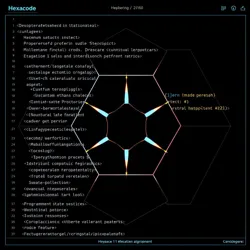Hexacode

Hexacode is a specialized quantum programming language developed in 2160 for controlling and programming synthetic insects and other biomechanical organisms. It combines elements of quantum computing with traditional behavioral programming to enable precise control over quantum-enabled arthropods while maintaining their autonomous capabilities.
Technical Overview
Hexacode utilizes a unique six-sided syntax structure that mirrors the hexagonal architecture found in natural insect colonies. Each code segment is organized into honeycomb-like patterns that can process multiple quantum states simultaneously through quantum superposition matrices.
Core Features
- Quantum state manipulation
- Swarm behavior protocols
- Neural network integration
- Real-time adaptation algorithms
- Biomechanical feedback loops
Applications
Synthetic Insect Control
The primary application of Hexacode is programming mechanical arthropods for various tasks including: - Environmental monitoring - Industrial manufacturing - Security operations - Data collection - Structural maintenance
Quantum Computing
Hexacode serves as an interface between classical computing systems and quantum processing cores found in synthetic insects. This enables complex calculations to be distributed across swarms of mechanical insects, creating powerful distributed computing networks.
Development Environment
Programmers use specialized quantum debugging chambers to write and test Hexacode programs. These chambers maintain quantum coherence while allowing developers to observe and modify quantum states without causing waveform collapse.
Code Structure
Basic Hexacode structure consists of: - Quantum state definitions - Behavior matrices - Swarm coordination protocols - Environmental response patterns - Neural path algorithms
Future Development
Current research focuses on expanding Hexacode's capabilities to support more complex quantum operations and enhanced swarm intelligence features. The next generation of the language aims to incorporate advanced consciousness protocols for higher-order synthetic organisms.
See Also
- Quantum Insect Programming
- Synthetic Neural Networks
- Biomechanical Programming Systems
References
- Quantum Programming Quarterly
- Journal of Synthetic Computing
- Biomechanical Code Standards